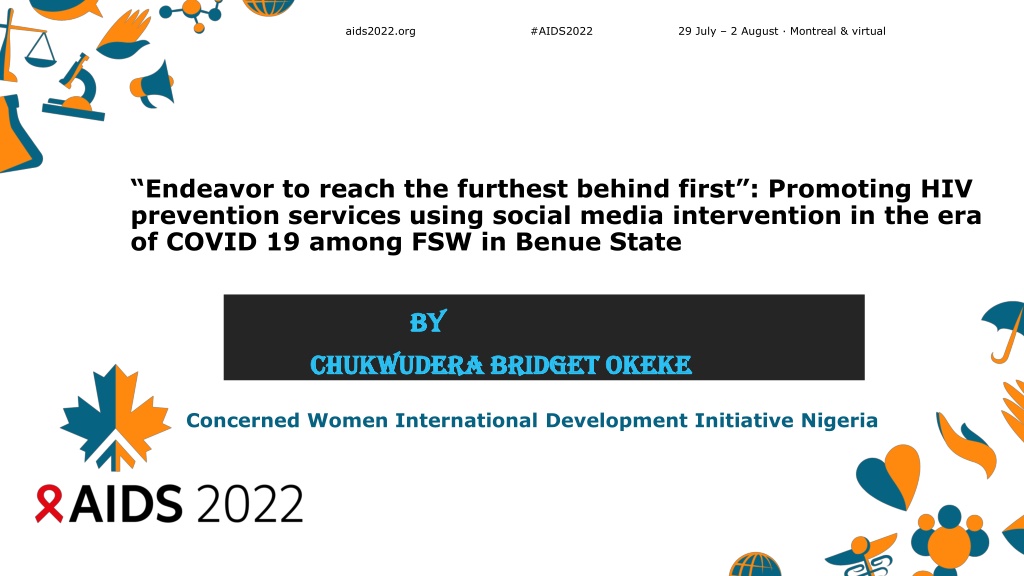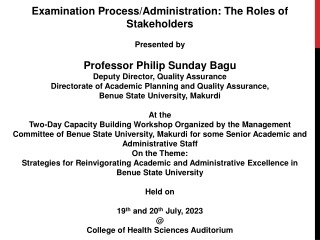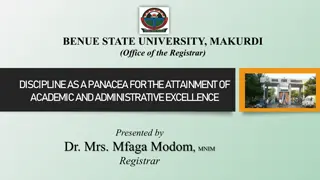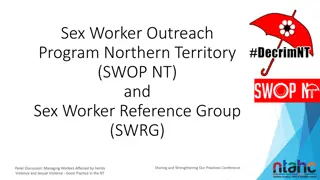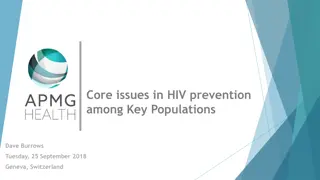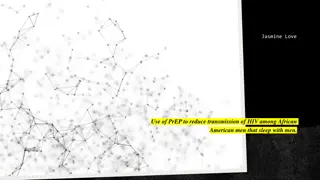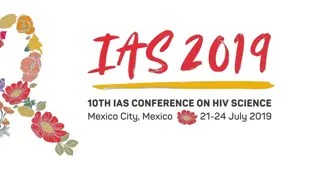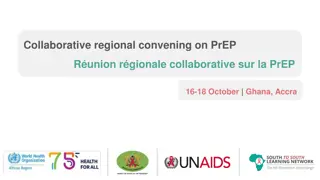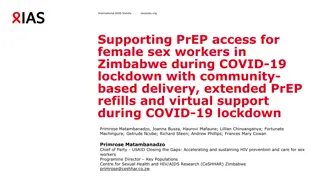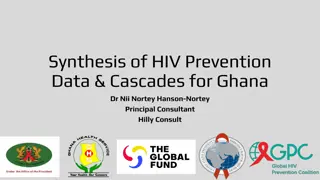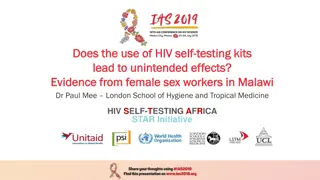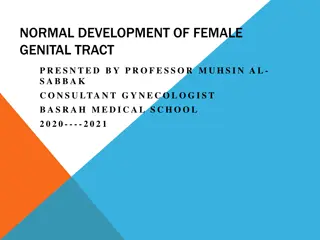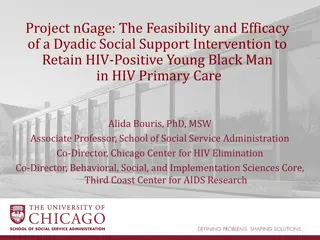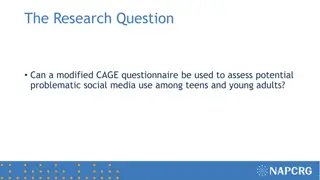Promoting HIV Prevention Services Among Female Sex Workers in Benue State Using Social Media Intervention
Female sex workers in Benue State, Nigeria faced challenges accessing HIV prevention services during COVID-19. To address this, a study utilized social media mobilization to reach and engage them, resulting in increased uptake of HIV testing services (HTS) compared to physical outreach. Through trained social media mobilizers and targeted messaging, 620 FSWs were reached, with 530 receiving HTS services via social media. This innovative approach demonstrates the effectiveness of online mobilization in reaching vulnerable populations for essential health services.
Download Presentation

Please find below an Image/Link to download the presentation.
The content on the website is provided AS IS for your information and personal use only. It may not be sold, licensed, or shared on other websites without obtaining consent from the author. Download presentation by click this link. If you encounter any issues during the download, it is possible that the publisher has removed the file from their server.
E N D
Presentation Transcript
aids2022.org #AIDS2022 29 July 2 August Montreal & virtual Endeavor to reach the furthest behind first : Promoting HIV prevention services using social media intervention in the era of COVID 19 among FSW in Benue State By By Chukwudera Bridget Okeke Chukwudera Bridget Okeke Concerned Women International Development Initiative Nigeria
Outline Introduction Methods Result Implication of result Conclusions 29 July 2 August Montreal & virtual aids2022.org #AIDS2022
Background Sex workers in Nigeria are among one of the vulnerable populations affected by the COVID-19 pandemic because of the nature of their work for instance physical distancing . Also, total ban on human-to-human interactions (lockdown) and other strict measures adopted by most countries including Nigeria to reduce the spread of COVID-19 restricted access to HIV prevention services among key populations especially for the female sex workers. More innovative approaches for mobilizing FSW to access critical HIV treatment and prevention services became critical. We deployed online mobilization through social media and study how it was effective compared to the physical approaches over 6 months in Benue State.
Method 20 FSW were trained as social media mobilizers to engage FSW through social networking platforms such as Facebook, WhatsApp, and Instagram IEC materials were developed in local dialects and posted on selected social media platforms to raise awareness regarding HIV prevention strategies as well as COVID 19 prevention messages for FSW. The trained social media mobilizers engaged FSW that access these platforms through one on-one interpersonal communication and provided HIV testing, and refereed FSW for COVID-19 test. We also recorded FSW that was reached through physical outreach We extracted data from the register recording total number of FSW that access HIV testing services (HTS) and COVID-19 testing and compared the two finding using
Fig 1: Distribution of FSW uptake of HTS in 6 months disaggregated by mode of mobilization Results 800 120.00% Uptake of HTS: We noticed from August to December 2020 that social media is a safe space for communication and mobilizing FSW for HTS service delivery. Fig 1. shows that social media accounted for mobilization of 620 FSWs amongst which 530 received HTS services as against physical outreach sensitization which mobilize only 112. 732 % OF HTS UPDATE BY METHOD OF MOBILIZATION 700 100.00% 620 602 600 530 80.00% 500 FREQUENCY 400 60.00% 300 40.00% 200 112 20.00% 100 72 0 0.00% Social Media Physical Outreach AXIS TITLE Total 29 July 2 August Montreal & virtual aids2022.org #AIDS2022 # Recurited # uptake HTS Linear (# uptake HTS )
0.00% 2.00% 4.00% 6.00% 8.00% 10.00% 12.00% 14.00% 16.00% 18.00% % HTS positive Test Result: There is an increased uptake of HTS by those reached through social media resulting to a high positive yield 4.53% positivity rate in 530 tested). Fig 2: shows high positive yield of HIV test result amongst participating FSW as against those reached through physical outreaches (11.1% in 72 tested) 602 Total Total 15.64% 732 72 Physical Outreach Physical Outreach 11.11% 112 530 Social Media Social Media 4.53% 620 0 100 200 300 400 500 600 700 800 Axis Title # uptake HTS # Recurited % positive TR #AIDS2022 Fig2: % HTS positive test result by FSW mobilization strategy 29 July 2 August Montreal & virtual aids2022.org Linear (% positive TR)
Inconsistent male condom use: FSW who were mobilized through social media reported high (about 61.29%) inconsistent male condom used in the last 6 months as against those recruited through physical outreach (53.57%). Fig 3: Reported inconsistent male condom use by FSW disaggregated by mode of mobilization 700 # recurited , 620 600 % reported iCU, 61.29% 500 # reported iCU, 380 400 300 200 # recurited , 112 % reported iCU, 53.57% 100 # reported iCU, 60 0 # recurited 620 112 # reported iCU 380 60 % reported iCU 61.29% 53.57% Social Media Physical Outreach Social Media Physical Outreach
700 600 COVID-19 test result: There was increased reach and identification FSW who were COVID-19 positive amongst those mobilized through social media (N=33; 5.32%) compared to those mobilized through physical (N=5; 4.46%). Social media provided a good platform for COVID-19 case identification and infection management amongst highly stigmatized population including FSW. 500 400 300 200 100 0 Positive test 33 5 # tested 620 112 % positive 5.322580645 4.464285714 Social media Physical outreach Social media Physical outreach 29 July 2 August Montreal & virtual aids2022.org #AIDS2022
Implication of the result We noticed that FSW were restricted by several COVID-19 restriction which could prevent easy access to HTS. Social media provided an affective alternative mobilization as against the traditional physical approach. More so, more FSW recruited through social media were more comfortable to communicate their personal HIV risk behaviours in the last 6 months like inconsistent condom use because social media provided a more private and confidential platform to elicit these critical program information. Also, because of high volume of FSW recruited through social media, it seems to facilitate opportunity for easy identification and testing of social sexual networks existing amongst them. This accounted for the HIV positive high yield we reported which is essential for deploying more targeted program for them. 29 July 2 August Montreal & virtual aids2022.org #AIDS2022
Conclusion HIV programs targeting FSW should prioritize use of social media for sensitization and mobilization of community members for more individualize and differentiated services delivery. 29 July 2 August Montreal & virtual aids2022.org #AIDS2022
